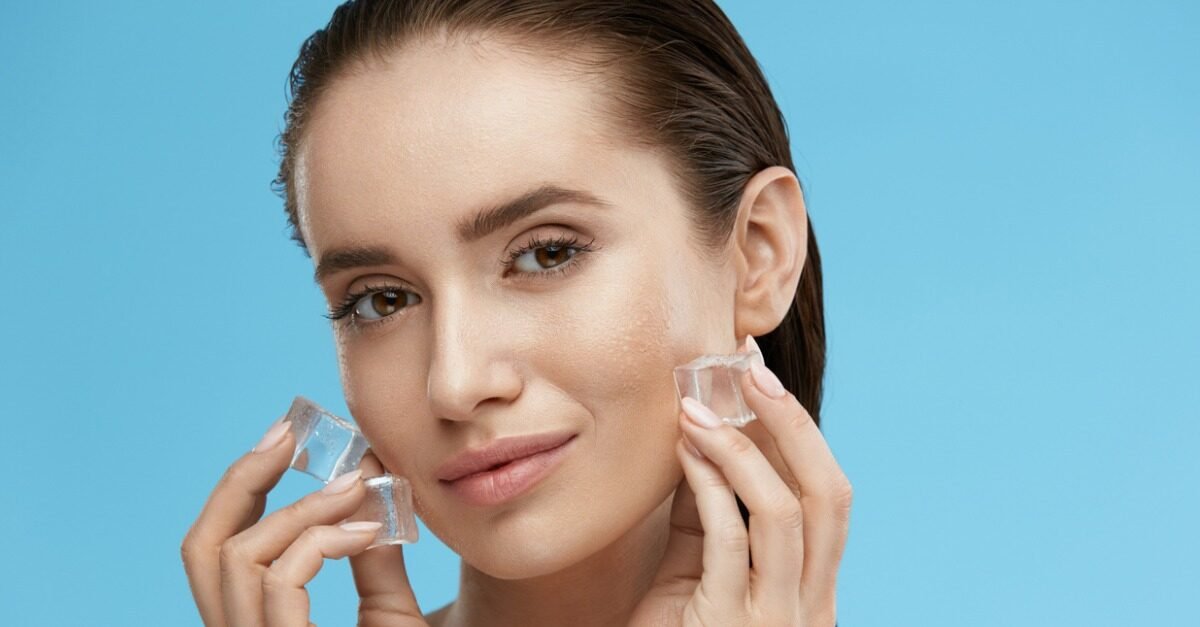Benefits of Icing Your Face Daily – Refreshing and Rejuvenating
In the ever-evolving world of skincare, the simplest practices often yield the most powerful results. One such age-old yet increasingly popular beauty ritual is face icing. This refreshing technique involves applying ice or ice-cold tools directly to the face—and the results can be transformative.

From reducing puffiness to achieving a radiant glow, applying ice to your face daily has numerous science-backed and dermatologist-approved benefits.
GLet’s explore the top 8 proven benefits of icing your face daily, how to do it safely, and why it could be the game-changer your skincare routine needs.
1. Reduces Facial Puffiness and Swelling
One of the most noticeable and immediate benefits of face icing is its ability to reduce puffiness—especially in the morning. Cold temperatures cause blood vessels to constrict, helping to reduce fluid retention in the face. This is particularly effective around the eyes, where puffiness is often pronounced.
How it works:
- Cold therapy tightens skin tissues.
- It minimizes fluid retention caused by poor sleep or a salty diet.
- Reduces inflammation from allergies or tiredness.
Pro tip: Use an ice roller or chilled spoon to massage the under-eye area.
2. Minimizes Pores for a Smoother Look
Large, open pores can give your skin a rough texture. Daily face icing tightens the skin and constricts pores, making them appear smaller. This not only smooths the skin’s surface but also helps control excess oil production.
How it helps:
- Cold constricts pore openings temporarily.
- Prevents dirt and makeup from getting trapped.
- Improves the overall appearance of your skin texture.
- Consistency is key—regular icing gives the best pore-refining results.
Read: Best 7-Step Skin Care Routine To Reduce Visible Pores: For Smoother, Clearer Skin
3. Reduces Acne and Inflammation
If you struggle with breakouts or redness, icing your face can help reduce inflammation associated with acne. Cold therapy can soothe inflamed pimples, reduce swelling, and even minimize the appearance of post-acne scars over time.
Benefits for acne-prone skin:
- Reduces redness and irritation.
- Slows down excessive sebum production.
- Prevents acne from worsening.
Tip: Wrap ice in a clean cotton cloth and hold it on active breakouts for a few seconds. Never apply ice directly on bare skin.
Also watch: Natural Ways to Clear Acne Fast
4. Improves Blood Circulation for a Natural Glow
Icing stimulates blood flow to the skin, promoting oxygen and nutrient delivery. As the cold causes blood vessels to contract and then dilate, your skin gets a fresh supply of circulation, leading to a healthy, radiant glow.
How it works:
- Boosts skin metabolism.
- Improves cell regeneration.
- Creates a rosy, vibrant complexion without makeup.
Many makeup artists use face icing as a pre-makeup ritual to achieve a natural glow and longer-lasting foundation.
5. Soothes Sunburn and Irritated Skin
Icing is a natural remedy for sunburn and skin irritation. If you’ve spent too much time in the sun or used a strong skincare product, applying ice can help calm the skin and reduce the burning sensation.
Ice helps by:
- Reducing inflammation from UV damage.
- Alleviating redness and discomfort.
- Speeding up the skin’s healing process.
Aloe vera ice cubes are especially effective for sunburn relief—simply freeze pure aloe vera juice and apply to affected areas.
Continue: Why You Should Never Skip Sunscreen – Even Indoors!
6. Delays Signs of Aging
Regular face icing can help tighten skin, slow the appearance of wrinkles, and reduce the visibility of fine lines. The cooling effect stimulates collagen production over time, making your skin look firmer and more youthful.
Anti-aging benefits:
- Improves skin elasticity.
- Prevents sagging and dullness.
- Enhances firmness and tone.
Combine icing with an anti-aging serum or vitamin C for an even greater effect. Icing helps your skin absorb products better.
7. Calm Skin Before and After Hair Removal
Whether you’re waxing, threading, or shaving, facial hair removal can often lead to irritation, redness, and bumps. Icing the skin before and after hair removal helps numb the area, reduce pain, and minimize inflammation.
How icing helps:
- Numb nerve endings to reduce discomfort.
- Closes pores to prevent dirt and bacteria from entering.
- Prevents ingrown hairs and redness.
Apply an ice cube wrapped in a soft cloth to the area for 2–3 minutes before your grooming session.
8. Enhances Product Aborption
Did you know that face icing can boost the effectiveness of your skincare products? When your skin is cold, blood flow improves, and product penetration becomes more effective. Applying serum or moisturizer after icing can help it reach deeper skin layers.
Enhanced absorption means:
- Better hydration and nourishment.
- More visible and lasting skincare results.
- Less product wastage.
Use your favorite serum after icing while your skin is slightly damp and your pores are refreshed.
Keep reading: Best Face Serums for Every Skin Type: Oily, Dry & Combination
How to Ice Your Face Safely
While face icing offers numerous benefits, it’s essential to do it safely to avoid damaging your skin. Here are a few tips:
✅ Do:
- Wrap ice cubes in a soft cloth or use an ice roller.
- Limit each session to 1–2 minutes per area.
- Use gentle circular motions.
- Ice your face in the morning or before bedtime.
- Follow up with a hydrating moisturizer or serum.
❌ Don’t:
- Apply ice directly on the skin without a barrier.
- Use dirty or unfiltered water to make ice cubes.
- Ice your face for more than 10–15 minutes.
- Ice broken, sensitive, or severely irritated skin.
Pro tip: Add natural ingredients like green tea, rose water, cucumber juice, or aloe vera to your ice cubes for enhanced skincare benefits.
Who should avoid icing?
Although face icing is generally safe for most skin types, some individuals should proceed with caution or avoid it altogether:
Sensitive skin: May react negatively to extreme cold.
Rosacea or broken capillaries: Icing can worsen symptoms.
Cold allergies or skin conditions: Always consult a dermatologist.
When in doubt, do a patch test or talk to your skincare professional before starting face icing.
Face icing tools you can try
If traditional ice cubes feel messy or uncomfortable, consider investing in tools designed for face icing:
Popular options include:
- Ice rollers: Easy to use and reusable.
- Cryo globes: Stylish, effective cooling globes for facial massage.
- Silicone ice molds: Create custom ice cubes with fruit, tea, or oils.
- NoCooling face masks: Gel-based masks that can be chilled and reused.
These tools are gentle on the skin and provide a spa-like experience at home.
Final Thoughts
Adding face icing to your daily skincare routine is a simple, affordable, and powerful way to improve your skin’s health and appearance. From reducing puffiness to enhancing your glow, cold therapy offers multiple benefits that both skincare enthusiasts and experts swear by.
Just a few minutes a day can make a visible difference. Whether you’re looking to fight breakouts, tighten pores, or achieve that fresh, dewy look—face icing might be the coolest skincare secret you’ve been missing.
FAQs About Face Icing
Q: How often should I ice my face?
A: Daily icing is safe for most people, especially in the morning. Start with 3–5 times a week and adjust based on your skin’s response.
Q: Can I use flavored or herbal ice cubes?
A: Yes! Green tea, rose water, cucumber, and aloe vera ice cubes add extra skin-loving nutrients.
Q: Is face icing better in the morning or at night?
A: Both work well! Morning icing reduces puffiness, while nighttime icing calms the skin before bed.
Ready to chill your way to flawless skin? Try face icing and feel the cool benefits every day.




